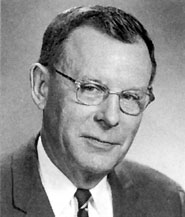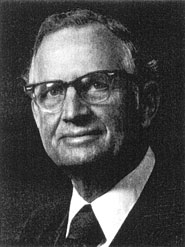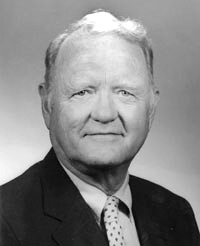
The Town of Carrboro sued Duke Energy in December 2024 for the corporation’s decades-long role as a leader of a nationwide climate deception scheme that has worsened the climate crisis, harmed communities and cost the town millions of dollars. The lawsuit seeks to hold Duke Energy accountable for the damages inflicted on Carrboro by the corporation’s campaign to delay the transition from planet-heating fossil fuels to renewable energy.
Below are some of the leaders of Duke Energy and its subsidiaries over the years – executives cited in the lawsuit as among the national ringleaders of a conspiracy of deception starting as early as the 1960s. The information below are examples of how utility executives knew about the dangers of greenhouse gas emissions from burning fossil fuels and the resulting climate impacts, how they downplayed those impacts to the public, and that they continued to pursue burning fossil fuels as the main energy source for the corporation.

W.B. McGuire
President of Duke Power 1959-1971
- 1968: Attended a convention of the Edison Electric Institute (EEI), the utility industry’s leading trade association, where a leading scientist explained how “at the anticipated levels of fuel consumption by the year 2000, the CO2 level in the entire earth’s atmosphere…” could trigger “catastrophic effects” on the climate.

Shearon Harris
President of Carolina Power & Light (now a subsidiary of Duke Energy) 1963-1976 and CEO 1969-1979
- 1972: While serving as chair of EEI, helped launch the Electric Power Research Institute (EPRI) in 1972, championing a 1971 report calling for research into greenhouse gas impacts on the climate. The founding president of EPRI wrote in 1971 about the dangers of fossil fuels causing a “greenhouse effect.”
- Harris served as the Chairman of EPRI’s Board of Directors until 1977, the year in which prominent scientist Merril Eisenbud warned EPRI that the use of fossil fuels could “increase the global temperature sufficiently to cause profound climatic changes.”

William S. Lee
President and/or CEO of Duke Power 1978-1994
- 1981: Served on an “Energy Research Advisory Board” (ERAB), which issued a report calling CO2 a possible “showstopper” for fossil fuels. The report said ERAB members were “in strong agreement” that CO2 research would have long term significance toward the use of fossil fuels.
- 1989: Lee was within the leadership of the Edison Electric Institute (EEI) for many years, which issued a publication casting doubt on the seriousness of fossil fuel emissions. In 1991, EEI supported a test marketing campaign designed to “Reposition global warming as theory (not fact)” through ads like the one pictured above.

James E. Rogers Jr.
CEO of Cinergy Corporation (now a subsidiary of Duke Energy) 1995-2006; President and CEO of Duke Energy Corporation 2006-2013
- 1995: Cinergy was a member of the Global Climate Coalition (GCC). A scientist sent a draft report to the GCC saying that the potential impact of human emissions on climate was “well established and cannot be denied.” The final report approved by the GCC removed this language and called claims that human activities had already significantly impacted the climate “unsubstantiated.”
- 2004: Rogers devoted Cinergy’s entire annual report to a discussion of global warming. The report cast doubt on the certainty of the “science” of global warming – with science in quotation marks.
- 2008: Served on American Coalition for Clean Coal Electricity’s (ACCCE) board of directors, the same year the organization ran a Christmas marketing campaign featuring cartoon lumps of coal singing carols against a snowy background. In another ad, ACCCE marketed “clean coal” as a way to “limit greenhouse gases.”
- 2008: Duke Energy issued a “Sustainability Report” touting carbon capture & storage as a “breakthrough technology for a low-carbon future” and a solution to the problem of CO2 emissions. The same year, Rogers admitted that CCS as a magical solution to the carbon problem was “oversold” and that it would take “a lot longer for us to figure it out than a lot of us think.”
Duke Energy’s deceptive practices continue today.
Only 1.8% of Duke Energy’s generated power in 2023 came from renewable energy (defined as solar and hydroelectric), according to Duke Energy’s 2023 Annual Report, despite years of running ads boasting wind turbines and solar panels. As of last year, Duke Energy in the Carolinas has the largest planned buildout of gas-fired generation of any electric utility in the nation.
Still, Duke Energy Corporation claims it is taking “bold action” to address climate change and has made “strong progress” in what the corporation calls “the energy transition.”
*Watch for part 2 of this list of “leaders.”
**See updates on the lawsuit and take action at SueDukeEnergy.org.
Sources:
Legal Complaint filed by the Town of Carrboro against Duke Energy Corporation
Energy and Policy Institute Report: “Duke Energy Knew”
